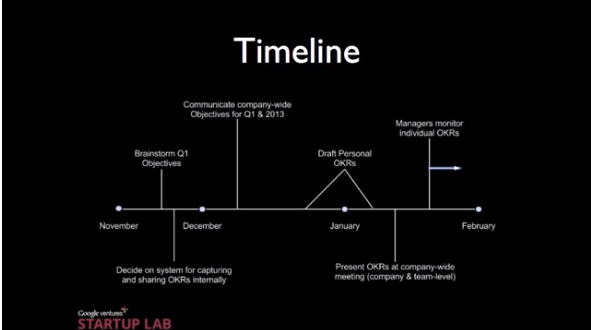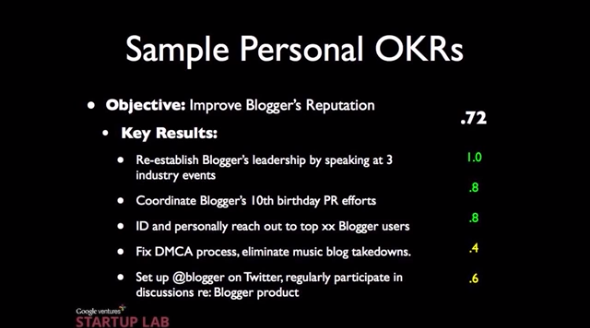Objectives and Key Results
I was introduced by my friend Julia to Google’s OKR system in our discussion in helping manage teams’ accountability to goals during the accelerator program.
Recently I started tracking my own project in this format, and thought about implementing this system within our team, and perhaps in the program.
A timely article on Business Insider introduced me to this post: Startup Lab workshop—How Google sets goals: OKRs by Rick Klau (Product Partner at Google Ventures).
This workshop recording is excellent. Rick Klau went over:
- what are OKRs
- how to implement
- how to adopt at your own company
His live video is here, and these are my notes.
A High Level View of OKR #
Keys to OKR #
- set quarterly and annually (annual OKRs are not set in stone)
- measurable
- set at personal, team, and company levels
- publicly available to everyone in the organization
- graded each quarter by yourself (OKR owner)
Why OKR? #
John Doerr #
John Doerr introduced OKR to Google when Google was under 1 year old. He was trying to reinforce:
- roll everything up from the foundation level will reflect the ultimate company priorities
- individual objectives may not reflect the overall objectives
Virtuous Cycle #
Each company goes through a goal setting exercise naturally.
- Company objectives set by Board and Managements: so departments and individuals know
- Individuals can set goals that is interesting to them and also feed into company’s goal
- Paul Buchheit thought he could make Mail searchable and became Gmail
- more than half of the companies objectives need to be coming from the bottom up—inspire the individuals
Googlers View on OKR #
OKR is data: it tells you what to do and what not to do.
- it shows you what you are working on
- it shows how well you are working towards those goals
- it is essential that OKR is measurable
- it is set from quarter to quarter
- it requires individual grading
- the scores matter less than the process
OKR’s Advantages #
- imposing discipline
- helps define what to work on and what not to work on
- making the OKR public, everyone can see exactly what everyone is working on, helps others figure out what your priorities are
- measurability Key Results establishes how to measure whether we are reaching the goals and how far we are
- everyone is working towards the same results
- focus efforts and coordination
- confidence that comes from knowing you can rely on other people’s responsibilities
How to define OKR? #
Rick Klau used an analogy of a football team to help us understand the difference between Individual’s, Team’s, and Company’s OKRs.
49ers Objective for individuals/units #
- GM wants to make money for owners by winning and filling the stadium (Company’s OKR)
- Head Coach wants to win the Super Bowl (Team’s)
- Public Relations want to fill the stand (Team’s)
- Defensive coordinators wants to hold the opponent in check (Individual’s)
- Offensive coordinators wants to complete downs (Individual’s)
- Special teams wants blocks, returns (Individual’s)
In general terms, the following are some of his tips on defining OKRs.
Objectives (looking forwards) #
- define the goal
- be a little uncomfortable (targeting 0.6-0.7/1.0)
- anything close to 1.0 you are sandbagging your goals
- under 0.7 you are not performing
- decide if other options are contributing to goals or a distraction
- objective should be uncomfortable—if you’re certain you will nail it, you’re not ambitious enough
- Team OKR is not a summary of all Personal OKRs, it should be what the most critical things are for the unit (same with Company OKR vs Team OKR)
Key Results (grading backwards) #
- measurable against the Objective goal
- connecting individual objectives to team’s, to company’s
- needs to be objectively assessable (observably measurable)
What to do to implement OKR? #
Personal OKR (this is around 35:00 in video) #
- Objectives: is often focused on growth, such as revenue, user, etc. Objectives can also be multiple experiments to learn about growth
- Key Results: has to be measurable, such as launch project, metric increased by X%, set dates, secure engineering resource
- You don’t want 12 objectives (a quarter is 12 weeks)
- max 5 objectives and 4 key results
Sometimes to achieve certain Objectives you need to conduct experiments. Don’t assume you have the answer, experiments to test impact. Key Results can be how many successful experiments that help you understand the growth.
Grading #
- Objective grading is an average of the key results
- Add up Objectives Grades and average it out for Quarter Objective
For Team and Company wide OKRs you review quarterly, and explain why you got the grade that you did, what you are going to do differently going into the next quarter, and set upcoming quarter’s OKR.
Communications between individuals and team #
- Individual and Team find a compromise in terms of goal and ultimately the Company’s goals
OKR is not an employee evaluation metric #
- look at the OKRs to remind you of the key things you work on and what is the impact
- it gives you a summary glance of what you have been working on
- look at the grades
- decide whether or not you made a difference
Adoption in Your Team #
Tools & Mentality #
- text fields and text boxes to enter grades in a form
- a way to roll up the Key Results scores to find average grade for Objectives
- use pragmatic tools like Google Sites, Wiki, Google Docs, or Google Spreadsheets
- everyone on the team needs to take this seriously and do this together and transparent
- buy in with peer pressure
Implementing a 3 months trial #
- Objectives: what are the three or four things that are important
- decide on a tool: how are you going to capture OKR and the entire team has access to it
- create one draft, and set up one meeting with manager/team, to come to a consensus before the quarter starts
- check in at about half way through the quarter, see if Individual or Team are on track
- grade individual/team/company at the end of the quarter
- host Company wide meeting to grade the quarter and restart the process
- at Company meeting do a reality check by drafting individual OKR and compare to Company OKR to find alignment
Blogger As An Example by Rick Klau #
Rick was the PM on Blogger after it was acquired by Google in 2007. He gave 3 examples in the video, and I wanted to use one that was simple to understand. This one didn’t touch on metrics in terms of numbers.
Example: Personal OKR #
Starting Point
- Objective: Improve Blogger’s Reputation
- Key Results:
1. Re-establish Blogger's leadership by speaking at 3 industry events 2. Coordinate Blogger's PR efforts 3. ID and personally reach out to top XX Blogger users 4. Fix DMCA process and eliminate mistaken music blog takedowns vs takedown of individual post (this was hurting reputation amongst a core constituent, music bloggers) 5. Set up Twitter and participate in discussionsGrading
- Objective: Improve Blogger’s Reputation. Grading: 0.72
- Key Results:
1. Re-establish Blogger's leadership by speaking at 3 industry events. Grading: 1.0 2. Coordinate Blogger's PR efforts. Grading: 0.8 3. ID and personally reach out to top XX Blogger users. Grading: 0.8 4. Fix DMCA process and eliminate mistaken music blog takedowns vs takedown of individual post (this was hurting reputation amongst a core constituent, music bloggers). Grading: 0.4 5. Set up Twitter and participate in discussions Grading: 0.6
In Summary #
Rick’s summed it up really well in his blog post.
Though the video goes into more detail, here are a few keys to what make OKRs work at Google:
- Objectives are ambitious, and should feel somewhat uncomfortable
- Key Results are measurable; they should be easy to grade with a number (at Google we use a 0 – 1.0 scale to grade each key result at the end of a quarter)
- OKRs are public; everyone in the company should be able to see what everyone else is working on (and how they did in the past)
- The “sweet spot” for an OKR grade is .6 – .7; if someone consistently gets 1.0, their OKRs aren’t ambitious enough. Low grades shouldn’t be punished; see them as data to help refine the next quarter’s OKRs.
ps. The notes are taken while I was watching the workshop recording. All terms are from Rick’s presentation. All credits to him!




